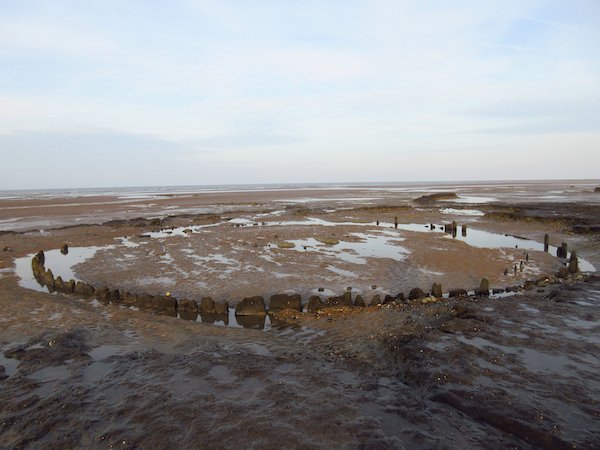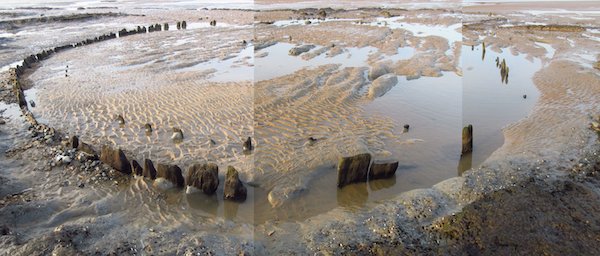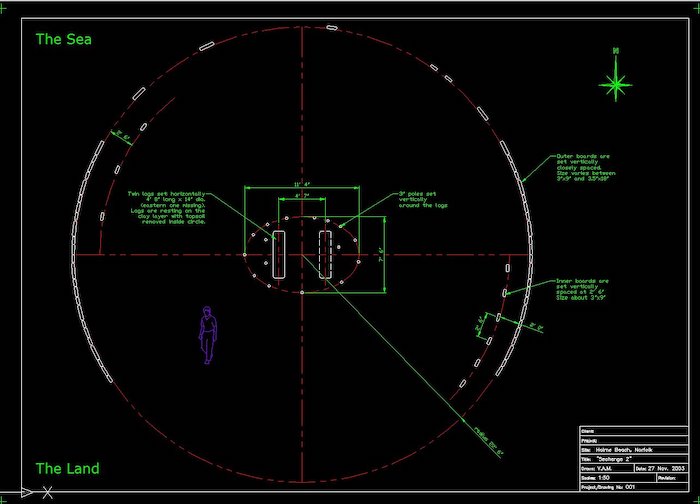Seahenge
On the beach at what is now Holme-next-the-Sea in the spring of 2050 BCE, a very large oak tree was felled and its stump was half-buried with the roots uppermost. About a year later,
some smaller oaks were felled and from these 56 posts were cut. These were arranged in a circle around the upturned, central stump. This Bronze-Age monument, described by some
archaeologists as being one of the most significant ever discovered, may have formed a type of ceremonial site - possibly with astronomical overtones. An alternative suggestion is that
it may have been a site of 'excarnation' where, after death, bodies would be exposed to the elements to hasten the process of decomposition and help the spirit on its way to the
afterlife.
Eventually the sea claimed the land where the circle stood and the people who built it were long forgotten. There were no records that it ever existed until, almost 4,000 years after
it was built, the ever shifting sands off the East Anglian coast reformed and revealed the structure once again to the eyes of man. The amazing structure was soon christened
'Seahenge' and became famous as Druids and modern-day pagans objected, including sit-in protests, against the decision by English Heritage to dig up the whole structure, remove it from
the beach and preserve it.
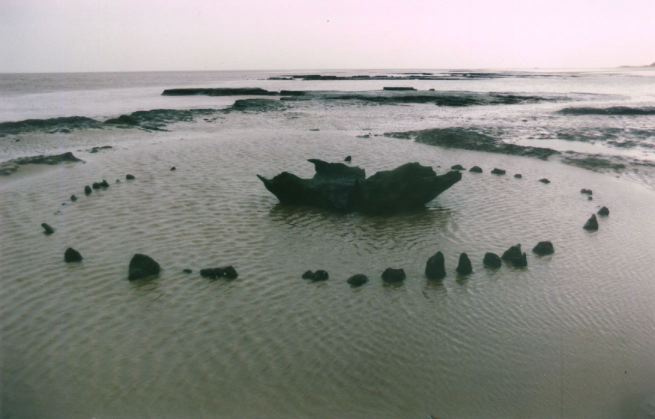
After much debate the future of the henge was decided and in the summer of 1999, and after being precisely photographed, measured and recorded, it was finally removed to the
Flag Fen Bronze Age Centre, near Peterborough. Whilst undergoing a preservation process the ancient timbers were subjected to detailed tree-ring dating (dendrochronology) and
carbon-dating.
Using these well-tested dating techniques a precise date was determined for the felling of the trees that make up the circle. From three possible dates obtained by the tree-ring analysis,
and after taking into account the carbon dating tests, the experts were left with just the one date - 2050 BCE. The actual time of year was further narrowed down to between April
and June when it was discovered from tree-ring examination that the main stump had been felled in the spring.
Following a £1.2 million redevelopment the Lynn Museum in King's Lynn is now home to
about half of the original timbers which are displayed in surroundings designed to replicate the beach site where they were discovered. There is also a life size replica of the Bronze Age circle. T
he entire display is accompanied by a free audio guide and interactive features which provide information about the people who created the monument and the details revealed by a study of the timbers.
Now, more than ten years after the initial discovery of the henge, experts at the Mary Rose Trust in Portsmouth have completed the complex task of preserving the timbers.
The water has been replaced with a synthetic wax so that the wood will not deteriorate further when exposed to the air. The stump, about 2.5 metres high and the same across and weighing more
than a tonne, is now on display to the public in the Lynn Museum. Special work has been carried out at the museum so that visitors will be able to walk around about half of the original timbers, which
will stand beside the full size replicas, with the hugh central stump completing the scene.
Update to the story - 8th December 2021
It has just been announced that, for the first time, a section of Seahenge is being loaned to another museum as part of the British Museum’s forthcoming exhibition The World of Stonehenge.
The exhibition, which will feature 430 objects and artefacts, will run from February 17 to July 17 2022 and is designed to tell the story of the iconic stone circle in Wiltshire - Stonehenge.
An import part of the collection will be approximately 15 of the original timbers from Seahenge - however the large, central stump will stay at the
Lynn Museum, where it is currently displayed.
At the British Museum, the World of Stonehenge project curator, Dr Jennifer Wexler said, "If Stonehenge is one of the world’s most remarkable surviving ancient stone circles, then
Seahenge is the equivalent in timber."
Further reading at:
Explore Norfolk UK.
Lynn Museum - Seahenge
Norfolk Heritage Explorer
Wikipedia
News of the second Seahenge!
In the first few days of July, 2014 the world was made aware that research by Norfolk County Council’s historic environment team has confirmed that a second timber circle on the
beach at Holme-next-the-Sea was made from trees felled in the first half of 2049 BCE - the same year as the first circle which was excavated in 1998-9.
This second ancient circle was discovered at the same time as the more famous Seahenge but unlike its sister was never excavated and was left intact at its original coastal location and
fully exposed to the elements of sea and weather.
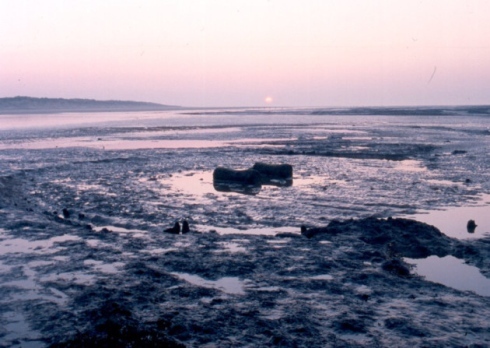
Whilst the second circle was temporarily revealed it was seen to be made up of four elements. There were two oak logs laid flat at its centre. These were surrounded by oak posts
forming an oval with oak branches inter-woven between them. To the east of the monument was an arc of split oak timbers. Finally, surrounding all this was an outer palisade of split
oak timbers, with the timbers set side by side.
Since its first disovery this 'sister of Seahenge' has gradually deteriorated due to the action of wind and waves and this erosion has been monitored. Fortunately
dendrochronology tests (tree ring dating) were carried out before the evidence was lost forever.
6th January 2023 update
Vince Matthews, a regular visitor to Holme-next-the-Sea for many years, has taken many photos of the village and has shared with us the following...
The first image was captured in 2003 as Seahenge II was recently exposed...
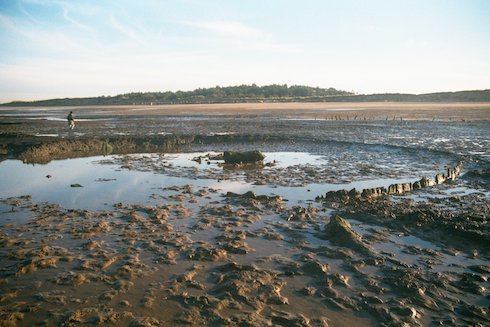
This CAD (Computer Aided Design) drawing by Vince shows his measurements of the timber circles and other features in 2003. You may have to enlarge the image to see all the detail, so
click anywhere on the map for a larger version and you can then scroll around to see all the details...
This second photo shows Seahenge II as it was revealed again in December 2022.
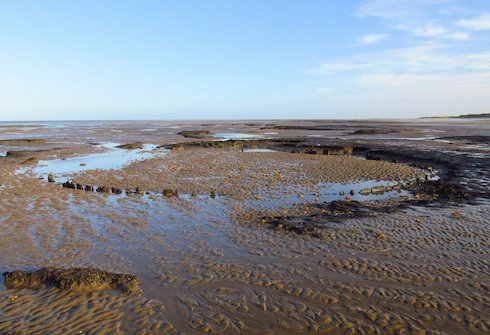
2nd July 2023 update
Steve King (Steve King Ltd) has kindly provided the following two photos of Seahenge II taken on 2nd July 2023...
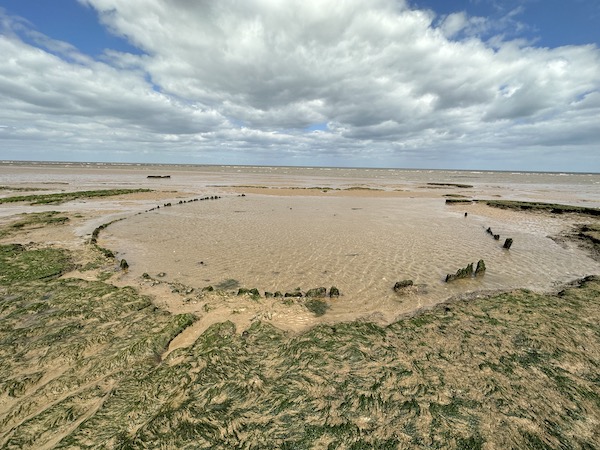
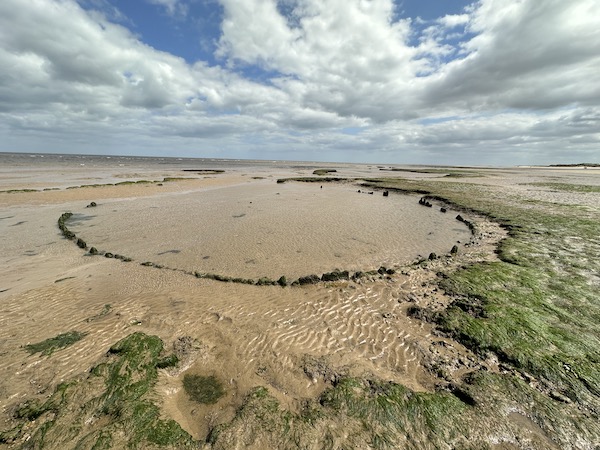
February 2025 update
Vince Matthews, who has previously contributed to this information page about Seahenge II, has very kindly sent this update and two more photos to illustrate the changes he describes:
I have just visited Holme-next-the-Sea again and noticed the Forest Bed has been stripped back from the structure exposing more timbers on the landward side while it also appears some timbers on the
east side are now either missing or eroded below water/sand level. The two Blue Clay lumps in the middle that supported the two logs (now gone) still seem to be there.
I have attached one photo of the whole structure and, because I didn't have a wide angle lens with me, a composite photo taken from closer up.
